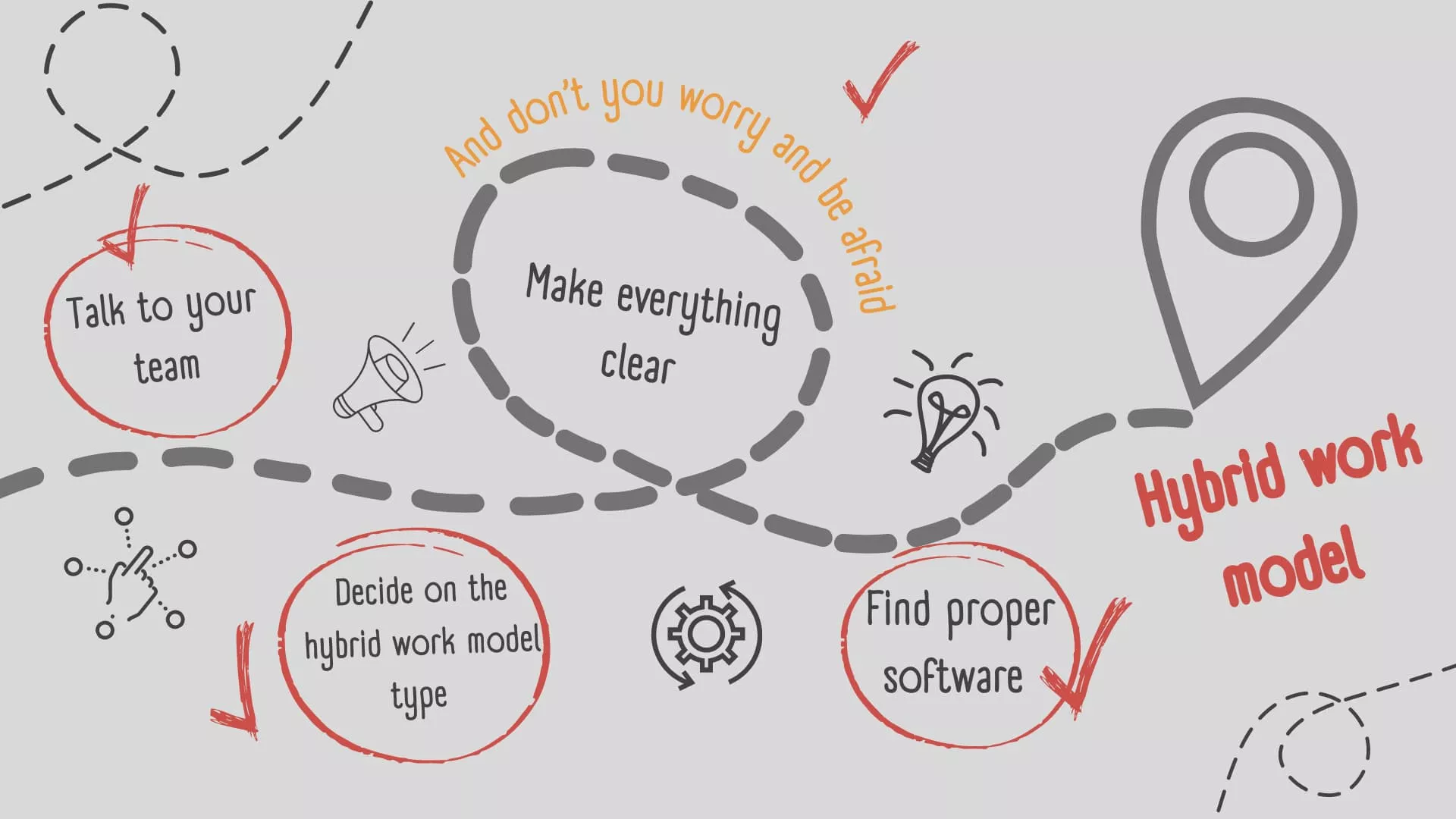What Is Hybrid Work, And How to Make It Work?

After Covid-19, working remotely has become the norm. And now employees aren’t really willing to go back to basics (office work), and according to the 2020 Slack survey, 72% of them prefer a hybrid work model.
But why? What is so special about hybrid working? And how to implement it wisely? Let us show you.
So, what is a hybrid work model?
We’ll start with ABC. The hybrid work model is basically what it’s called. It stands somewhere between office work and a fully remote one, which is pretty easy to guess, and it gives employees a choice. Thus, you may have in-office and virtual teams cooperating on the same projects. However, hybrid working doesn’t mean absolutely identical workflows and actually has a spectrum.
Types of hybrid working
So, yeah. You, as a business owner, also have a right to choose whatever type is good for you and your team. There are four main types of hybrid work models, but some businesses may work with a few of them at the same time or even do it their way (you remember, it’s a spectrum).

Flexible hybrid work model
Well, the title speaks for itself. This type is absolutely flexible, and employees can choose not only the place, but also the working hours they feel are the most productive. One of the companies that opt for the flexible hybrid work model is Cisco. They announced that they are not going to return to office work, leaving their employees to decide when and where to work.
Fixed hybrid work model
With a fixed hybrid work model, a company sets certain days of the week when workers are allowed to work remotely or lets them choose those days but obliges them to inform managers in advance. The rules may differ from team to team or even be individual. However, this model is more about agreement than total freedom. Microsoft, for example, allows employees to work from home 50% of the time if they make a schedule beforehand.
Office-first hybrid work model
The name is pretty clear – most working hours are supposed to be spent on-site and the rest remotely. At Apple, for example, employees come to the office on Monday, Tuesday, and Thursday, while Wednesday and Friday remain free of the obligatory office visit.
Remote-first hybrid work model
And here, we work remotely most of the time and visit the office only for team buildings or certain meetings where live interaction is important. Such a hybrid work model type is often used by companies that don’t have an office, and employees there may meet whenever they need and wherever they want.
How to build a good hybrid working environment?
Implementing a hybrid working model helps businesses keep up with the times and broaden their horizons. However, it might be pretty challenging and require a particular attitude.
“Like many companies, we started thinking about a hybrid work model after Covid-19. And it wasn’t easy at first. But then we looked at hybrid working from a different perspective and realized that it’s a wonderful way to scale up the business,” – says Synebo COO Kateryna Mishei.
So, we’d like to share here a few tips on how to ease the process of building a good hybrid working environment.

Talk to your team
Communication is the basis of building a good working environment in general. And the right approach to communicating with your employees will eliminate toxicity inside your company’s virtual workplace and help you with team management.
When you’re trying to change how your team members work, you should definitely talk to them and ask about their opinion and preferences. Ensure that everyone has all the required tools. Understand how they see it so that you can find the best ways to implement the hybrid work model.
Decide on the hybrid work model type
After you figure out what your employees expect from a new work model, you can have a better idea of which hybrid work model type or types they need.
Make everything clear
Introduce the new working model a company chooses to the team. Create a plan for the step-by-step implementation (when it starts, which teams go first, etc.). Share all needed information with the employees. Make sure everyone is aware of the process and their assigned role.
Synebo COO, Kateryna Mishei, suggests documenting everything:
“Consistency and process documentation – that’s what really helps to implement the hybrid work model effectively. In 2020, we created an internal Wikipedia and had been actively updating it since then. So, every step is clear for all old and new employees”.

Find proper software
Your digital tools need to be selected in such a way that they are easy to use and helpful both for office and remote workers. At Synebo, for example, we’ve developed our own software that allows us to do literally everything: from keeping track of the workflow, to managing salary and extra payments.
By the way, to sort things out and make a better sense of what digital tools are a great choice for your team, you can go through our article about remote team management.
And don’t you worry and be afraid
Changes might seem scary. But when you know how many new opportunities they will bring, you better forget your fears and try.
“Don’t be afraid of challenges. Trust your employees, but also instill in them a sense of personal responsibility. Be flexible, and change the model if the initial approach doesn’t work”, Kateryna Mishei says.
So, let’s make it work
Now you know the essentials of a hybrid work model implementation. And all that remains is to start. Our team, in turn, is here for you in case you need some help with the technical part. So, when you decide to choose software for your on-site and remote teams – contact us, and we will explain, find and build anything you need. See ya!






























































